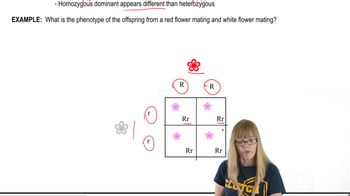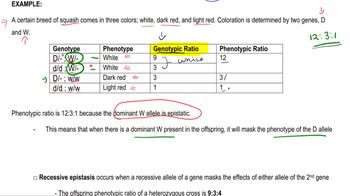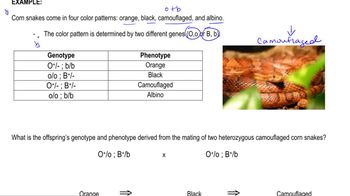Table of contents
- 1. Introduction to Genetics51m
- 2. Mendel's Laws of Inheritance3h 37m
- 3. Extensions to Mendelian Inheritance2h 41m
- 4. Genetic Mapping and Linkage2h 28m
- 5. Genetics of Bacteria and Viruses1h 21m
- 6. Chromosomal Variation1h 48m
- 7. DNA and Chromosome Structure56m
- 8. DNA Replication1h 10m
- 9. Mitosis and Meiosis1h 34m
- 10. Transcription1h 0m
- 11. Translation58m
- 12. Gene Regulation in Prokaryotes1h 19m
- 13. Gene Regulation in Eukaryotes44m
- 14. Genetic Control of Development44m
- 15. Genomes and Genomics1h 50m
- 16. Transposable Elements47m
- 17. Mutation, Repair, and Recombination1h 6m
- 18. Molecular Genetic Tools19m
- 19. Cancer Genetics29m
- 20. Quantitative Genetics1h 26m
- 21. Population Genetics50m
- 22. Evolutionary Genetics29m
3. Extensions to Mendelian Inheritance
Epistasis and Complementation
Problem 31
Textbook Question
Human ABO blood type is determined by three alleles, two of which (I^A and I^B) produce gene products that modify the H antigen produced by protein activity of an independently assorting H gene. A rare abnormality known as the 'Bombay phenotype' is the result of epistatic interaction between the gene for the ABO blood group and the H gene. Individuals with the Bombay phenotype appear to have blood type O based on the inability of both anti-A antibody and anti-B antibody to detect an antigen. The apparent blood type O in Bombay phenotype is due to the absence of H antigen as a result of homozygous recessive mutations of the H gene. Individuals with the Bombay phenotype have the hh genotype. Use the information above to make predictions about the outcome of the cross shown below.
IᴬIᴮHh×IᴬIᴮHh
 Verified step by step guidance
Verified step by step guidance1
Identify the genotypes of the parents: Both parents have the genotype I^A I^B Hh, which means they are heterozygous for both the ABO blood group alleles and the H gene.
Determine the possible gametes each parent can produce: Each parent can produce four types of gametes: I^A H, I^A h, I^B H, and I^B h.
Set up a Punnett square to predict the offspring's genotypes: Create a 4x4 Punnett square using the gametes from each parent to find all possible combinations of offspring genotypes.
Analyze the offspring genotypes: Look for combinations that result in the Bombay phenotype (hh) and those that result in different ABO blood types (A, B, AB, or O) based on the presence of the H antigen.
Summarize the phenotypic ratios: Determine the expected phenotypic ratios of the offspring, considering both the ABO blood group and the potential for the Bombay phenotype.
Recommended similar problem, with video answer:
 Verified Solution
Verified SolutionThis video solution was recommended by our tutors as helpful for the problem above
Video duration:
4mPlay a video:
Was this helpful?
Key Concepts
Here are the essential concepts you must grasp in order to answer the question correctly.
ABO Blood Group System
The ABO blood group system is determined by the presence of specific antigens on the surface of red blood cells, which are encoded by three alleles: I^A, I^B, and i. The I^A and I^B alleles are co-dominant, meaning that both can be expressed simultaneously, resulting in blood types A (I^A I^A or I^A i), B (I^B I^B or I^B i), AB (I^A I^B), or O (ii). Understanding this system is crucial for predicting blood type inheritance in offspring.
Recommended video:
Guided course

Variations on Dominance
Epistasis
Epistasis refers to the interaction between genes where the expression of one gene is affected by one or more other genes. In the case of the Bombay phenotype, the H gene's product is necessary for the expression of A and B antigens. If an individual has two recessive alleles (hh) for the H gene, they will not produce the H antigen, leading to a phenotype that appears as blood type O, regardless of their ABO genotype.
Recommended video:
Guided course

Epistatic Genes
Genotype and Phenotype
Genotype refers to the genetic constitution of an individual, while phenotype is the observable physical or biochemical characteristics resulting from the genotype and environmental influences. In the context of the Bombay phenotype, individuals with the hh genotype exhibit a phenotype that masks their true ABO blood type, demonstrating how genotype can influence phenotype through epistatic interactions.
Recommended video:
Guided course

Gamete Genotypes

 5:05m
5:05mWatch next
Master Complementation with a bite sized video explanation from Kylia Goodner
Start learning



